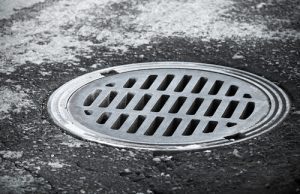Pests From Sewer Systems
By Chris Williams on February 29, 2012.
Q. I don’t understand how cockroaches and rats and other pests can live in sewer systems. What are they feeding on?
A. Many of our common pests will feed on just about any kind of organic material, especially decaying or rotting material. Organic material is anything that is animal or plant in origin. In sewers, organic material is supplied in the form of food garbage scraps from kitchen garbage disposals, partially digested food in the form of human waste from toilets, and even rotting plant material that accumulates in storm drains. There’s a wealth of pest food available in our sewer systems.
 An urban sewer system is a network of underground pipes that removes wastewater from toilets and kitchens, and also handles storm water runoff. Pests in underground sewer systems live in a protected environment; temperatures are fairly constant year round, humidity is high, food is available year round, and there is little disturbance. This means that sewer pests can develop and reproduce year round.
An urban sewer system is a network of underground pipes that removes wastewater from toilets and kitchens, and also handles storm water runoff. Pests in underground sewer systems live in a protected environment; temperatures are fairly constant year round, humidity is high, food is available year round, and there is little disturbance. This means that sewer pests can develop and reproduce year round.
Not all urban sewer systems are the same. In some cities, household waste is handled separately from storm water. In these cities, the two types of wastewater are diverted to separate pipes. Other municipalities have older combined systems that direct household wastewater and storm water into the same network of pipes. Then, the combined discharge is sent to a sewage treatment facility. Of the two types of sewage systems, this combined system is more likely to support pests and allows free movement in and out.
It would be one thing if the various sewer pests remained in the sewers, but they often leave the sewers and move into our homes and buildings. Phorid flies and drain flies are often associated with a sewage line break under the slab of a home or other building. The flies escape from the sewer lines and then breed in the organic “goo” that leaks from the broken pipe. These flies and cockroaches can get into buildings from a sewer backup, a break in the slab, or through floor drains that have been allowed to dry out. Rats move out of sewer systems at breaks in the drainpipes and then burrow up into yards. They can also follow lateral lines directly into buildings, swimming up through ungrated floor drains and up through toilets. Sewage treatment plants can contribute their own pest problems. Drain flies, also called sewage flies, can live and breed in sewage plant filters and sometimes cause a problem for residents living nearby.
Controlling pests in sewers can be a complicated legal and regulatory issue because the sewers are generally owned by a sewer authority and not by the property owners. Only the sewer authority has the legal right (and responsibility) to control pests, or to allow a pest control company to control pests, in the sewers. Controlling sewer pests can be a major undertaking often involving multiple city or county agencies, pest control contractors, and property owners. Often, control is met with little success due to the aging infrastructure of the sewer system.